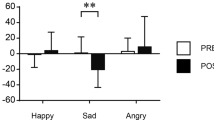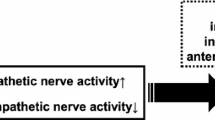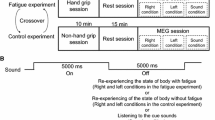Abstract
In this review, fatigue is described as a conscious sensation rather than a physiological occurrence. We suggest that the sensation of fatigue is the conscious awareness of changes in subconscious homeostatic control systems, and is derived from a temporal difference between subconscious representations of these homeostatic control systems in neural networks that are induced by changes in the level of activity. These mismatches are perceived by consciousness-producing structures in the brain as the sensation of fatigue. In this model, fatigue is a complex emotion affected by factors such as motivation and drive, other emotions such as anger and fear, and memory of prior activity. It is not clear whether the origin of the conscious sensation of fatigue is associated with particular localised brain structures, or is the result of electrophysiological synchronisation of entire brain activity.


Similar content being viewed by others
References
Derman EW, A St Clair Gibson, Schwellnus MP, et al. The differential diagnosis and clinical approach to the athlete with clinical fatigue [online]. Available from URL: http://www.esportmed.com/ismj/. Int Sportmed J 2000, 1
Hagberg M. Muscular endurance and surface electromyogram in isometric and dynamic exercise. J Appl Physiol 1981; 51: 1–7
Gandevia SC. Spinal and supraspinal factors in human muscle fatigue. Physiol Rev 2001; 81: 1725–89
Vogeley KT, Seitz RJ. Representation and identity: convergence of brain research and mind-brain philosophy. J Hist Neurosci 1995; 4: 183–203
Rees G, Kreiman G, Koch C. Neural correlates of consciousness in humans. Nat Rev Neurosci 2002; 3: 261–70
Searle JR. How to study consciousness scientifically. Philos Trans R Soc Lond B Biol Sci 1998; 353: 1935–42
Crick F. The astonishing hypothesis: the scientific search for the soul. New York: Scribner, 1994
Fitts RH. Cellular mechanisms of muscle fatigue. Physiol Rev 1994; 74; 49–94
Green H. Mechanisms of muscle fatigue in intense exercise. J Sports Sci 1997; 15: 247–56
Hargreaves M, McKenna MJ, Jenkins DG, et al. Muscle metabolites and performance during high-intensity, intermittent exercise. J Appl Physiol 1998; 84: 1687–91
Sahlin K, Tonkonogi M, Soderland K. Energy supply and muscle fatigue in humans. Acta Physiol Scand 1998; 162: 261–6
Balsom PD, Gaitanos GC, Soderlund K, et al. High intensity exercise and muscle glycogen availability in humans. Acta Physiol Scand 1999; 165: 337–45
Coggan AR, Coyle EF. Reversal of fatigue during prolonged exercise by carbohydrate infusion or ingestion. J Appl Physiol 1987; 63: 2388–95
Costill DL, Bennett A, Branam G, et al. Glucose ingestion at rest and during prolonged exercise. J Appl Physiol 1973; 34: 764–9
Coyle EF, Coggan AR, Hemmert MK, et al. Muscle glycogen utilization during prolonged strenuous exercise when fed carbohydrate. J Appl Physiol 1986; 61: 165–72
McConnell G, Snow RJ, Proietto J, et al. Muscle metabolism during prolonged exercise in humans: influence of carbohydrate availability. J Appl Physiol 1999; 87: 1083–6
Bassett DR, Howley ET. Maximal oxygen uptake: ‘classical’ versus ‘contemporary’ viewpoints. Med Sci Sports Exerc 1997; 29: 591–603
Howley ET, Bassett DR, Welch HG. Criteria for maximal oxygen uptake: review and commentary. Med Sci Sports Exerc 1995; 27: 1292–301
Myers J, Ashley E. Dangerous curves: a perspective on exercise, lactate, and the anaerobic threshold. Chest 1997; 111: 787–95
Mihevic PM. Sensory cues for perceived exertion: a review. Med Sci Sports Exerc 1981; 13: 150–63
Noble BJ, Metz KF, Pandolf KB, et al. Perceptual responses to exercise: a multiple regression study. Med Sci Sports 1973; 5: 104–9
Pandolf KB, Burse RL, Goldman RF. Differentiated ratings of perceived exertion during physical conditioning of older individuals using leg-weight loading. Percept Mot Skills 1975; 40: 563–74
Bongiovanni LG, Hagbarth KE. Tonic vibration reflexes elicited during fatigue from maximal voluntary contractions in man. J Physiol 1990; 423: 1–14
Hayward L, Breitbach D, Rymer WZ. Increased inhibitory effects on close synergists during muscle fatigue in the decerebrate cat. Brain Res 1988; 440: 199–203
Rotto DM, Kaufman MP. Effect of metabolic products of muscular contraction on discharge of group III and IV afferents. J Appl Physiol 1988; 64: 2306–13
Cafarelli E. Peripheral contributions to the perception of effort. Med Sci Sports Exerc 1982; 14: 382–9
Utter AC, Kang J, Nieman DC, et al. Effect of carbohydrate ingestion and hormonal responses on ratings of perceived exertion during prolonged cycling and running. Eur J Appl Physiol Occup Physiol 1999; 80: 92–9
Nybo L, Nielsen B. Perceived exertion is associated with altered brain activity during exercise with progressive hyperthermia. J Appl Physiol 1998; 91: 2017–23
Hampson DB, St Clair Gibson A, Lambert MI, et al. The influence of sensory cues on the performance of effort during exercise and central regulation of exercise performance. Sports Med 2001, 952
Pandolf KB. Differentiated ratings of perceived exertion during physical exercise. Med Sci Sports Exerc 1982; 14: 397–405
St Clair Gibson A, Lambert MI, Noakes TD. Neural control of force output during maximal and submaximal exercise. Sports Med 2001; 31: 637–50
Ulmer HV. Concept of an extracellular regulation of muscular metabolic rate during heavy exercise in humans by psychophysiological feedback. Experentia 1996; 52: 416–20
Morgan WP, Raven PB, Drinkwater BL, et al. Perceptual and metabolic responsivity to standard bicycle ergometry following various hypnotic suggestions. Int J Clin Exp Hypn 1973; 21: 86–101
Morgan WP, Hirta K, Weitz GA, et al. Hypnotic perturbation of perceived exertion, ventilatory consequences. Am J Clin Hypn 1976; 18: 182–90
Williamson JW, McColl R, Mathews D, et al. Hypnotic manipulation of effort sense during dynamic exercise: cardiovascular responses and brain activation. J Appl Physiol 2001; 90: 1392–9
Rejeski WJ, Ribisil PM. Expected task duration and perceived effort: an attributional analysis. J Sport Psychol 1980; 2: 227–36
Gibson H, Carroll N, Clague JE, et al. Exercise performance and fatiguability in patients with chronic fatigue syndrome. J Neurol Neurosurg Psychiatry 1993; 56: 993–8
Mullis R, Campbell IT, Wearden AJ, et al. Prediction of peak oxygen uptake in chronic fatigue syndrome. Br J Sports Med 1999; 33: 352–6
St Clair Gibson A. Fatigue, aging and the neuromuscular system [MD thesis]. Cape Town: University of Cape Town, 2002
Carson RG, Riek S, Shahbazpour N. Central and peripheral mediation of human force sensation following eccentric or concentric contractions. J Physiol 2002; 539: 913–23
Brasil-Neto JP, Pascual-Leone A, Valls-Sole J, et al. Postexercise depression of motor evoked potentials: a measure of central nervous system fatigue. Exp Brain Res 1993; 93: 181–4
Latash ML. Neurophysiological basis of movement. Champaign (IL): Human Kinetics, 1998
Pritchard TC, Alloway KD. Medical neuroscience. Maiden (MA): Blackwell Science Inc, 1999
von Helmholtz H. Treatise on physiological optics. Southall JPC, editor/translator. Menasha (WI): Optical Society of America, 1925: 3
McCloskey DI, Ebeling P, Goodwin GM. Estimation of weights and tensions and apparent involvement of a ‘sense of effort’. Exp Neurol 1974; 42: 220–32
Sperry RW. Neural basis of the spontaneous optokinetic response produced by visual neural inversion. J Comp Physiol Psychol 1950; 43: 482–9
Enoka RM, Stuart DG. Neurobiology of muscle fatigue. J Appl Physiol 1992; 72: 1631–48
Boutcher SH, Trenske M. The effects of sensory deprivation and music on perceived exertion and affect during exercise. J Sport Exerc Psych 1990; 12: 167–76
Masters KS, Ogles BM. Associative and dissociative cognitive strategies in exercise and running: 20 years later, what do we know? Sport Psychol 1998; 12: 253–70
LeDoux J. The emotional brain. London: Weidenfeld and Nicolson, 1998
Damasio A. The feeling of what happens: body, emotion and the making of consciousness. London: Vintage, 2000
Damasio A. Fundamental feelings [letter]. Nature 2001; 413: 781
Dougherty DD, Shin LM, Alpert NM, et al. Anger in healthy men: a PET study using script-image driven imagery. Biol Psychiatry 1999; 15: 466–72
Blair RJ, Morris JS, Frith CD, et al. Dissociable neural responses to facial expressions of sadness and anger. Brain 1999; 122: 883–93
Mayberg HS, Liotti M, Brannan SK, et al. Reciprocal limbiccortical function and negative mood: converging PET findings in depression and normal sadness. Am J Clin Psych 1999; 154: 675–82
Morris JS, Fristen KJ, Buchel C, et al. A neuromodulatory role for the human amygdala in processing emotional facial expressions. Brain 1998; 121: 47–57
Gorno-Tempini ML, Pradelli S, Serafini M, et al. Explicit and incidental facial processing: an fMRI study. Neuroimage 2001; 14: 465–73
Eichenbaum H. A cortical-hippocampal system for declarative memory. Nat Rev Neurosci 2000; 1: 41–50
Miller EK. The prefrontal cortex and cognitive control. Nat Rev Neurosci 2000; 1: 59–65
Parvizi J, Damasio A. Consciousness and the brainstem. Cognition 2001; 79: 135–59
Bassin PV, Berstein NA, Latash LP. On the problem of the relation between structure and function in the brain from a contemporary point of view. Motor Control 1999; 3: 332–42
Salinas E, Sejnowski TJ. Correlated neuronal activity and the flow of neural information. Nat Rev Neurosci 2001; 2: 539–50
Engel AK, Fries P, Singer W. Dynamic predictions: oscillations and synchrony in top-down processing. Nat Rev Neurosci 2001; 2: 704–16
Varela F, Lachaux JP, Rodriguez E, et al. The brainweb: phase synchronization and large-scale integration. Nat Rev Neurosci 2001; 2: 229–39
Blomstrand E, Hassmen P, Newsholme EA. Effect of branched-chain amino acid supplementation on mental performance. Acta Physiol Scand 1991; 143: 225–6
Guezennec CY, Abdelmalki A, Serrurier B, et al. Effects of prolonged exercise on brain ammonia and amino acids. Int J Sports Med 1998; 19: 323–7
Ide K, Schmalbruch IK, Quistorff B, et al. Lactate, glucose and O2 uptake in human brain during recovery from maximal exercise. J Physiol 2000; 522: 159–64
Kalsgaard MK, Ide K, Cai Y, et al. The intent to exercise influences the cerebral 02/carbohydrate uptake ration in humans. J Physiol 2002; 540: 681–9
Baars B. In the theatre of consciousness: the workspace of the mind. UK: Oxford University Press, 1997
St Clair Gibson A, Lambert EV, Lambert MI, et al. Exercise and fatigue control mechanisms [online]. Available from URL: http://www.esportmed.com/ismj/. Int Sport Med J 2001; 2(3)
Ceci R, Hassmen P. Self-monitored exercise in three different RPE intensities in treadmill vs field running. Med Sci Sports Exerc 1991; 23: 732–8
Dunbar CC, Robertson RJ, Baun R, et al. The validity of regulating exercise intensity by ratings of perceived exertion. Med Sci Sports Exerc 1992; 24: 94–9
Eston RG, Williams JG. Reliability of ratings of perceived effort regulation of exercise intensity. Br J Sports Med 1988; 22: 153–5
Acknowledgements
The Medical Research Council of South Africa, National Research Foundation of South Africa, Technology and Human Resources for Industry Programme of South Africa and the Harry Crossley Research Funds of the University of Cape Town provided financial assistance for studies described in this review. The authors have no conflicts of interest that are directly relevant to the content of this manuscript.
Author information
Authors and Affiliations
Corresponding author
Rights and permissions
About this article
Cite this article
Gibson, A.S., Baden, D.A., Lambert, M.I. et al. The Conscious Perception of the Sensation of Fatigue. Sports Med 33, 167–176 (2003). https://doi.org/10.2165/00007256-200333030-00001
Published:
Issue Date:
DOI: https://doi.org/10.2165/00007256-200333030-00001




